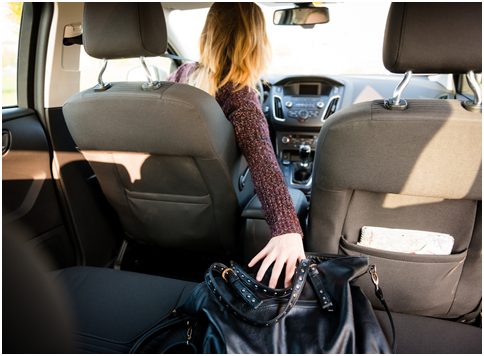Even though traffic deaths are on the decline, driving still poses a risk to motorists, cyclists and pedestrians. Distracted driving, speeding, recklessness and weather are all major contributors, but practicing safe driving habits can help lower your risk of getting into an accident. Luckily, there are a few simple things you can do to make every drive just a little bit safer, from eliminating distractions to investing in better safety features.
Curb Distracted Driving
One of the biggest contributors to fatalities and injuries is distracted driving. Research shows that distracted driving causes over 400,000 accidents per year, and that number has been steadily ticking upward. Smartphones and gadgets are undoubtedly a big reason for this, which is why so many states and cities have implemented hands-free laws.
Using a high-quality phone mount and voice commands can help you use your tech safely while on the go. But choosing the wrong one can increase your risk. Look for a style that’s secure and adjustable so you don’t put yourself at risk of messing with it while you’re on the road.
Here are some more ways to minimize distractions:
- Use a secure, magnetic phone mount and switch to voice commands while driving. Pay attention to the position and angle of the mount so that you can glance at your phone quickly and then turn your eyes back to the road.
- Turn your phone to Do Not Disturb mode. This setting prevents calls and texts from coming through, but still allows you to access your music, navigation, etc.
- Limit the number of passengers in your vehicle to three or four people and ask everyone to stay calm and quiet while you’re driving.
- Don’t eat while on the road. If possible, pull over for meals and snacks.
- Don’t multitask. Resist the urge to do anything but drive while behind the wheel. Even something as simple as trying to find your sunglasses can cause accidents.
- Make sure everything you need is accessible and within reach, so you don’t have to rifle through things or reach behind you to find your water bottle, sunglasses, etc. Invest in car organizers for the center console and back seats for the kids.
- Don’t drive while tired. Even if you feel slightly fatigued, stay off the road.
- Leave early. When you’re rushing, you’re not paying attention to what’s going on around you and are only focusing on getting to your destination on time. Always leave with plenty of time to get there safely.

Update Your Safety Features
As of 2018, Federal law requires that all passenger cars be equipped with rearview monitoring cameras. If your car was made before that, you may want to consider investing in a backup camera and monitor to help prevent accidents while backing out and parking. Even if your car did come standard with a backup cam, it may be worth your while to invest in a higher quality one that improves resolution and visibility.
If you don’t want to upgrade to a new car, there are a few other enhancements you can make in the meantime. While they’re not all cheap, they can drastically improve the performance and safety of your car, so consider them an investment. Here are some key safety features to consider upgrading.
- Upgrade your rearview camera. This is essential if you don’t already have one on your car or if your current one performs poorly in inclement weather.
- Install a dash cam on your windshield. A dash cam will help prevent accidents and road rage incidents. Bonus: Your insurance company may also see it as a reason to lower your premium!
- Install a head-up speedometer. Many drivers find that the factory speedometer is hard to read or find on the dash. A windshield display speedometer will help ensure that you can always clearly see how fast you’re going.
Make Sure You and Your Car Are Road Ready
If you break it down, most traffic accidents can be blamed on one of a few things — the motorist, the vehicle, and the roadway. While we don’t have any control over the quality and safety of the roads, we do have the ability to improve the performance and safety of our cars and to make sure we’re sharp, engaged drivers. Here are some ways to ensure that you and your car are prepared for the open, and not-so-open, road.
- Upgrade your tires. Tires are one of the most important pieces of safety equipment on your car, so make sure they’re appropriate for your terrain and in good shape.
- Brush up on the basics. You may not be required to take your driver’s test ever again, but that doesn’t mean you should stop learning. Brush up on the basics of local road laws and practice maneuverability on occasion.
- Perform routine inspections. Before you go anywhere, inspect the tires, give your brakes a quick test and make sure you’ve got enough gas to get where you’re going.
- Get comfortable before you leave. Set yourself up for safety and comfort before you even turn the car on by adjusting your seat, moving the mirrors and setting the radio.
- Practice defensive driving. Defensive driving means being prepared to react to others without assuming you know their intention and staying ready to identify hazards on the road. Be sure you understand defensive driving and use it every day. AAA offers affordable defensive driving courses to give you a refresher.
- Keep perspective. You need to know what’s going on immediately in front of you and way ahead of you while driving, so don’t stay too focused on one or the other.

Driving is a necessity of modern life which most of us rely on for work, play and general living. Unfortunately, it’s not something most of us can or would want to eliminate entirely. Luckily, there are some great things we can do to help make our time on the road enjoyable and less risky for everyone around us. Follow the above tips to help keep the roads safer and prevent accidents.






